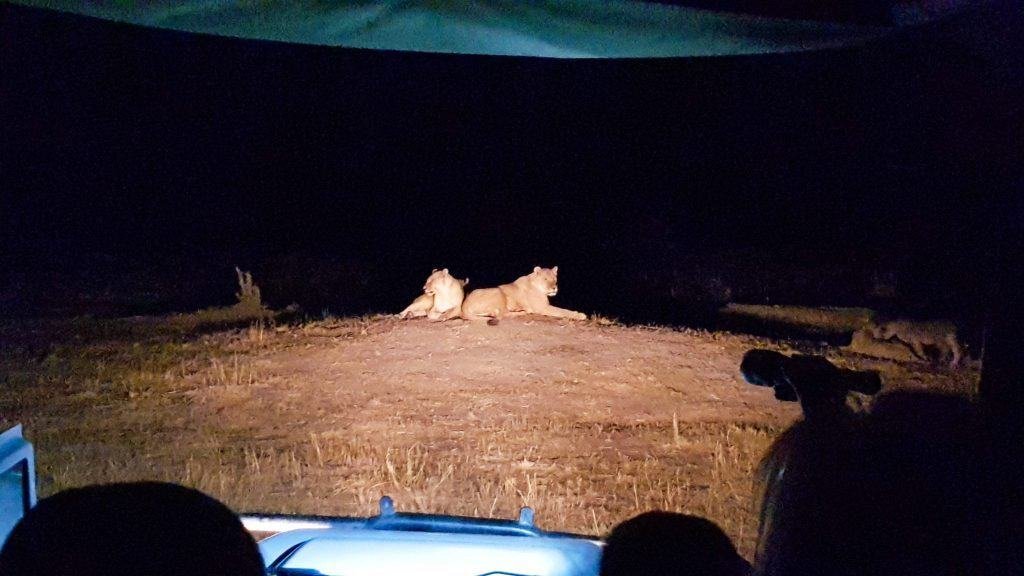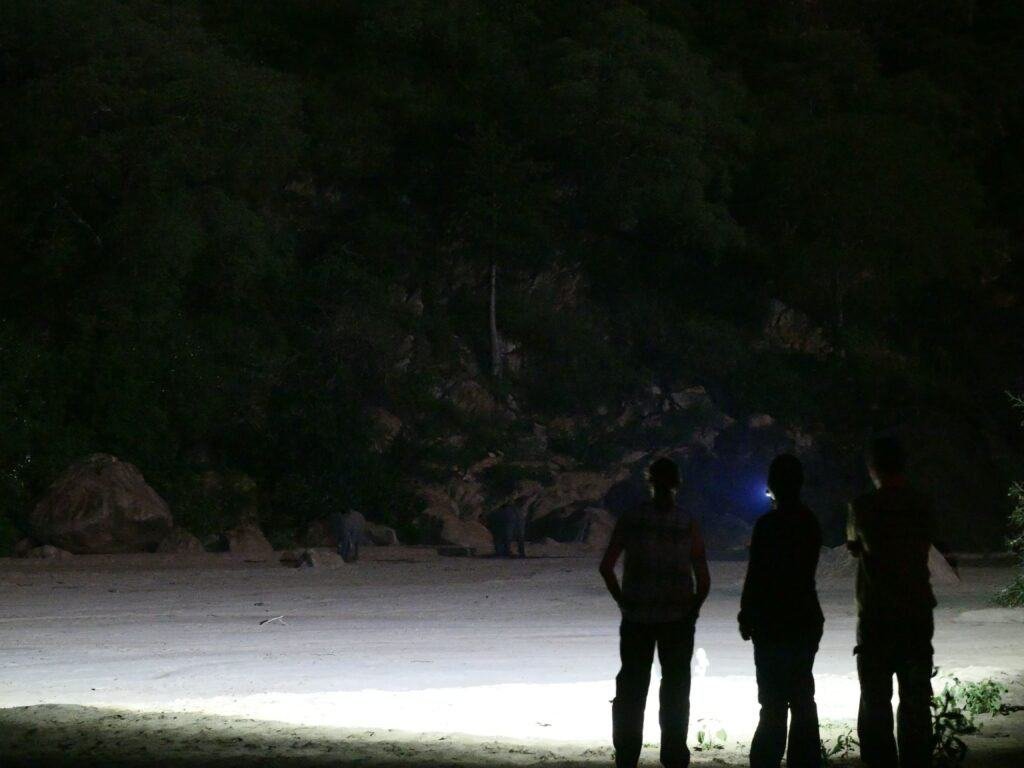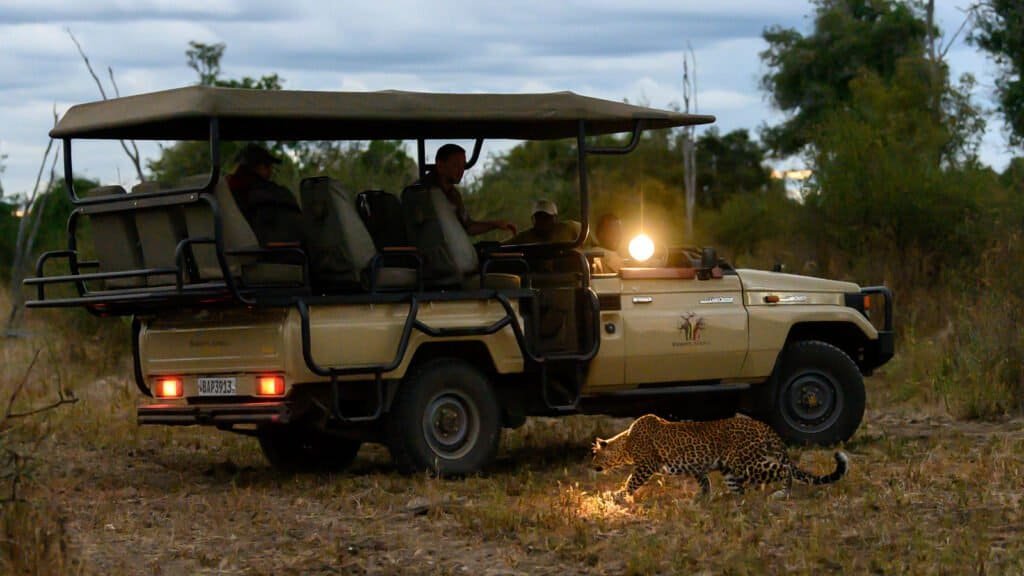Introduction
Being on an early-morning or afternoon game drive in the wilds of Africa, with the promise of getting close to animals in their natural habitat is a truly unique experience. But the thrills don’t have to stop at sundown – night safaris provide an exhilarating experience, offering a unique lens to view the continent’s rich wildlife.

Unlike traditional daytime safaris, night drives allow visitors to witness the mysterious behaviours of creatures that only emerge after dusk. Your guides will shed light on the nocturnal animals that call this land home and the distinctive experiences that night safaris offer.
Key Takeaways: Night Safaris and Nocturnal Wildlife
| Section | Key Points |
|---|---|
| Introduction | Overview of night safaris and their unique experiences in Africa. |
| Evolution of Night Safaris in Africa | Evolution from simple expeditions to sophisticated, conservation-focused experiences. |
| Nocturnal Wildlife: An Overview | Insight into the diverse nocturnal species of Africa and their ecological roles. |
| Types of Night Safaris | Various options include guided tours, self-drive, and walking safaris. |
| The Sensory Experience of Night Safaris | Night safaris engage different senses, offering a unique wildlife viewing experience. |
| Animal Behaviors at Night in Africa | Observation of unique nocturnal behaviours like hunting and mating rituals. |
| Conservation Efforts for Nocturnal Wildlife | Focus on protecting nocturnal species and their habitats through various initiatives. |
| Responsible Tourism Practices | Importance of minimizing disturbance and supporting local communities. |
| Technologies and Equipment | Advancements like night vision tools and eco-friendly innovations enhance safaris. |
| Safety Measures and Guidelines | Essential tips for ensuring a safe and respectful wildlife encounter. |
| Best Destinations for Night Safaris in Africa | Highlighting top African destinations for nocturnal wildlife experiences. |
| Planning Your Night Safari in Africa | Tips on the best times to visit, what to bring, and health precautions. |
| The Future of Night Safaris in Africa | Trends towards eco-tourism, technological advancements, and community involvement. |
Evolution of Night Safaris in Africa
After a slow start, night drives evolved to incorporate more sophisticated equipment and vehicles. The introduction of spotlighting, where powerful lights are used to spot animals in the dark, revolutionized night safaris. This practice has been refined to ensure minimal disturbance to wildlife by using red lights.
Red Spotlighting on Night Drives
Mammals, except for primates like us, often can’t see colors well and red light doesn’t affect their night vision much. Scientists are still studying if they can see red light at all. Mammals’ eyes have more rods, which detect light, than cones, which see colours. This is why many African mammals have great night vision.
The pupil in the eye controls how much light comes in. It adjusts slowly over the day, but bright artificial lights, like spotlights, can blind them suddenly because they have more rods.
When you see videos of night-time predators caught in bright white lights, they might sit or lie down. This isn’t a good sign; they are temporarily blinded and stay still until they can see again, which can take up to an hour.
Today, night safaris in Africa are a blend of adventure, education, and conservation. They are conducted with a deep respect for the natural habitat and the well-being of the nocturnal species.
Nocturnal Wildlife: An Overview

Unique Adaptations
Nocturnal animals in Africa have evolved unique adaptations to thrive in the dark. These adaptations include enhanced senses such as better hearing, sight, and smell.
Common Species
Commonly encountered nocturnal species on African night safaris include the elusive leopard (if you are lucky), the cunning hyena, and various species of owls and nocturnal birds. Smaller, less-seen creatures like the bushbaby and impala can also be spotted and if you see an aardvark then please let me know – you probably don’t realise quite how lucky you have been!
Ecological Roles
These nocturnal creatures play crucial roles in the ecosystem, from controlling pest populations to seed dispersal. Understanding their behaviours and roles offers insight into the complex web of the African wilderness.
Types of Night Safaris

Guided Tours
Guided tours are the most common form of night safaris in Africa, offering expert knowledge and enhanced safety. These tours use vehicles equipped with spotlights and are often led by experienced guides.
Self-Drive Safaris
Some reserves allow self-drive night safaris, offering a more personal and adventurous experience. These are typically recommended for more experienced safari-goers familiar with the terrain and wildlife behaviour.
The Sensory Experience of Night Drives in Africa
Engaging the Senses
Night safaris in Africa offer a sensory experience unlike any found during the day. The darkness heightens visitors’ senses, making every sound and movement more pronounced.
Hearing
The African night resonates with unique sounds: the distant roar of a lion, the laugh of hyenas, and the rustling of small creatures in the underbrush. These sounds create a symphonic backdrop that is both thrilling and educational.
Sight
Vision takes on a new dimension under the cover of darkness. Spotlights and night-vision equipment reveal the glowing eyes of nocturnal animals, offering glimpses into their secretive world.
Smell
The night air carries distinct scents, from the earthy aroma of the savannah to the subtle scent trails left by animals. This sense often alerts safari-goers to the presence of wildlife before they are seen.
Emotional and Psychological Impact
The mystery of the unknown and the thrill of potential encounters evoke a mix of excitement and reverence for nature. This unique combination of sensory engagement makes night safaris a deeply memorable experience. A game drive after sunset gets your heart racing!
Animal Behaviors at Night in Africa
Predatory Activities
Many of Africa’s predators are more active at night. Leopards, lions, and hyenas use the cover of darkness for hunting, utilizing their keen senses to track prey.
Hunting Strategies
Each predator has a unique hunting strategy that is often more observable during night safaris. For example, lions may hunt in packs, while leopards rely on stealth and surprise.
Mating Rituals
Nighttime is also a critical period for mating rituals among various species. The darkness provides a cover for intimate behaviours, and night safaris may offer rare glimpses into these private moments.
Territory Marking and Defense
Territorial behaviours, such as marking and patrolling, are common nocturnal activities. These are crucial for understanding the social structures and hierarchies within the animal kingdom.
Adaptations for Survival
Nocturnal animals have developed various adaptations for survival in the dark, from acute hearing and night vision to specialized hunting techniques. Observing these adaptations provides insight into the evolutionary marvels of African wildlife.
Conservation Efforts for Nocturnal Wildlife in Africa

Challenges Faced by Nocturnal Species
Nocturnal species face unique challenges, including habitat loss, human-wildlife conflicts, and poaching. These threats are often exacerbated by their elusive nature, making them harder to monitor and protect.
Conservation Initiatives
Various conservation initiatives focus on protecting nocturnal wildlife. These include research on nocturnal species’ behaviour, habitat preservation efforts, and anti-poaching campaigns.
Community Involvement
Involving local communities in conservation efforts is crucial. Educational programs and community-based tourism initiatives help foster a sense of stewardship and provide economic incentives for conservation.
The Role of Night Safaris in Conservation
Responsible night safaris play a role in conservation by raising awareness and generating funds. By showcasing the beauty and importance of nocturnal wildlife, these safaris help in garnering support for conservation efforts.
Responsible Tourism Practices for Night Safaris in Africa
Minimizing Disturbance
Tourists are encouraged to respect the natural behaviour of wildlife. This includes keeping noise to a minimum and using spotlights responsibly to avoid disturbing animals.
Environmental Impact
Responsible safari practices also involve minimizing environmental impact. This includes following designated routes to prevent habitat damage and adhering to park regulations.
Waste Management
Proper disposal of waste and avoiding littering are critical for maintaining the pristine nature of safari environments.
Supporting Local Communities
Choosing safari operators who work with and support local communities can contribute to sustainable tourism. This includes employing local guides and supporting community-owned lodges.
Education and Awareness
Tourists should educate themselves about the wildlife and environments they will encounter. Understanding the ecological and cultural significance of the areas visited enhances the safari experience and promotes respect for the natural world.
Technologies and Equipment for Night Safaris in Africa
Night Vision Tools
Advancements in night vision technology have greatly enhanced the night safari experience. Infrared and thermal imaging devices allow for the observation of wildlife without the need for visible light, thus minimizing disturbance to the animals.
Spotlighting
Spotlighting, when done responsibly, is a popular method for wildlife observation in Africa. These powerful lights can reveal hidden nocturnal creatures, but red light filters should be used where possible.
Photography Equipment
Nighttime photography on safaris has become increasingly popular. Equipment like high-ISO cameras and lenses suitable for low light conditions are essential for capturing the elusive moments of nocturnal wildlife.
Drones
While less common, drones equipped with night vision cameras can provide unique aerial perspectives of the nocturnal landscape. However, their use is strictly regulated in many reserves to prevent disturbance to wildlife and is generally part of anti-poaching or surveillance operations.
Communication Devices
For safety and coordination, especially in remote areas, reliable communication devices are crucial. This includes radios and GPS systems, ensuring that drivers can contact the lodge or other drivers if required.
Safety Measures and Guidelines for Night Safaris in Africa
Following Guide Instructions
The most important safety measure on a night safari is adhering to the instructions of the guide. Their expertise and understanding of animal behaviour are crucial for a safe experience. Familiarise yourself with additional aspects of safari etiquette in this article.
Wildlife Interactions
Maintaining a safe distance from wildlife is imperative. Nighttime can make animals more unpredictable, and respecting their space is key for the safety of both the animals and the visitors.
Emergency Protocols
Being aware of emergency protocols and having a first-aid kit are essential. Guides are typically trained in handling emergencies, but visitors should also be prepared if driving their own vehicle.
Vehicle Safety
Ensuring that vehicles are well-maintained and equipped for nighttime conditions is vital. This includes having proper lighting and communication equipment.
Personal Safety
Visitors should wear appropriate (warm) clothing and be prepared for the varied conditions of the African night, from temperature changes to potential insect bites.
Best Destinations for Night Safaris in Africa
South Africa
South Africa offers a plethora of options for night safaris, with its diverse landscapes and rich wildlife. Parks like Kruger National Park and private reserves in the Sabi Sand offer unforgettable nocturnal experiences.
Kenya
Kenya’s Masai Mara is renowned for its night safaris, providing opportunities to see the Big Five and other nocturnal creatures in their natural habitat in private conservancies.
Tanzania
Many of Tanzania’s national parks and conservation areas offer unique night safari experiences, with a chance to witness an abundance of nocturnal predators. The parks in remote southern Tanzania are a far better bet than their more famous northern counterparts.
Namibia
Namibia’s desert landscapes provide a different night safari experience, with opportunities to see rare desert-adapted species under the stars.
Botswana
Botswana’s Okavango Delta and Chobe National Park are known for their pristine wilderness and the possibility of a sunset boat cruise on the Chobe offers a different perspective on nocturnal life.
Planning Your Night Safari in Africa
Best Times to Visit
The best time for night safaris in Africa varies by region and the type of wildlife you wish to see. Generally, the dry season offers better visibility and wildlife viewing opportunities.
What to Bring
Essential items include warm clothing for the cooler night temperatures, binoculars, cameras suitable for low light, and insect repellent.
Health Precautions
Visitors should take necessary health precautions, including vaccinations and malaria prophylaxis where required. It’s also important to have travel insurance that covers safari activities.
Cultural Sensitivity
Understanding and respecting the local culture and customs of the areas visited enhances the experience and supports sustainable tourism practices.
The Future of Night Safaris in Africa
Emerging Trends
The future of night safaris in Africa is shaped by emerging trends like eco-tourism and technological advancements. There is a growing emphasis on sustainable practices that ensure minimal impact on wildlife and their habitats.
Eco-friendly Innovations
Innovations like electric safari vehicles and low-impact lighting are becoming more prevalent, reducing noise and pollution and enhancing the natural experience of night safaris.
Enhanced Wildlife Research and Monitoring
Advances in technology are not only improving the safari experience but also aiding in wildlife research and monitoring. This contributes to more effective conservation strategies for nocturnal animals.
Community-based Tourism
The future also sees a rise in community-based tourism, where local communities play a central role in managing and benefiting from night safari operations. This approach promotes conservation and provides economic benefits to local populations.
The Role of Education and Awareness
Education and awareness about nocturnal wildlife and their ecosystems are expected to be a significant focus. This involves integrating educational elements into safari experiences, thereby fostering a deeper appreciation and understanding of the importance of conservation efforts.
Conclusion
A Unique Safari Experience
Night drives in Africa offer a unique and exhilarating way to experience the continent’s diverse wildlife. They provide an intimate glimpse into the lives of nocturnal animals and their behaviours, which would otherwise remain hidden in the daylight.
Importance of Conservation
These safaris also play a crucial role in conservation efforts by raising awareness and generating funds for wildlife protection. By choosing responsible safari operators and following best practices, visitors can contribute to the preservation of these magnificent creatures and their habitats.
Final Thoughts
As night safaris continue to evolve, they hold the promise of offering even more sustainable, educational, and unforgettable experiences. The future of these safaris lies in balancing the thrill of adventure with the responsibility of protecting Africa’s nocturnal wildlife for generations to come.
